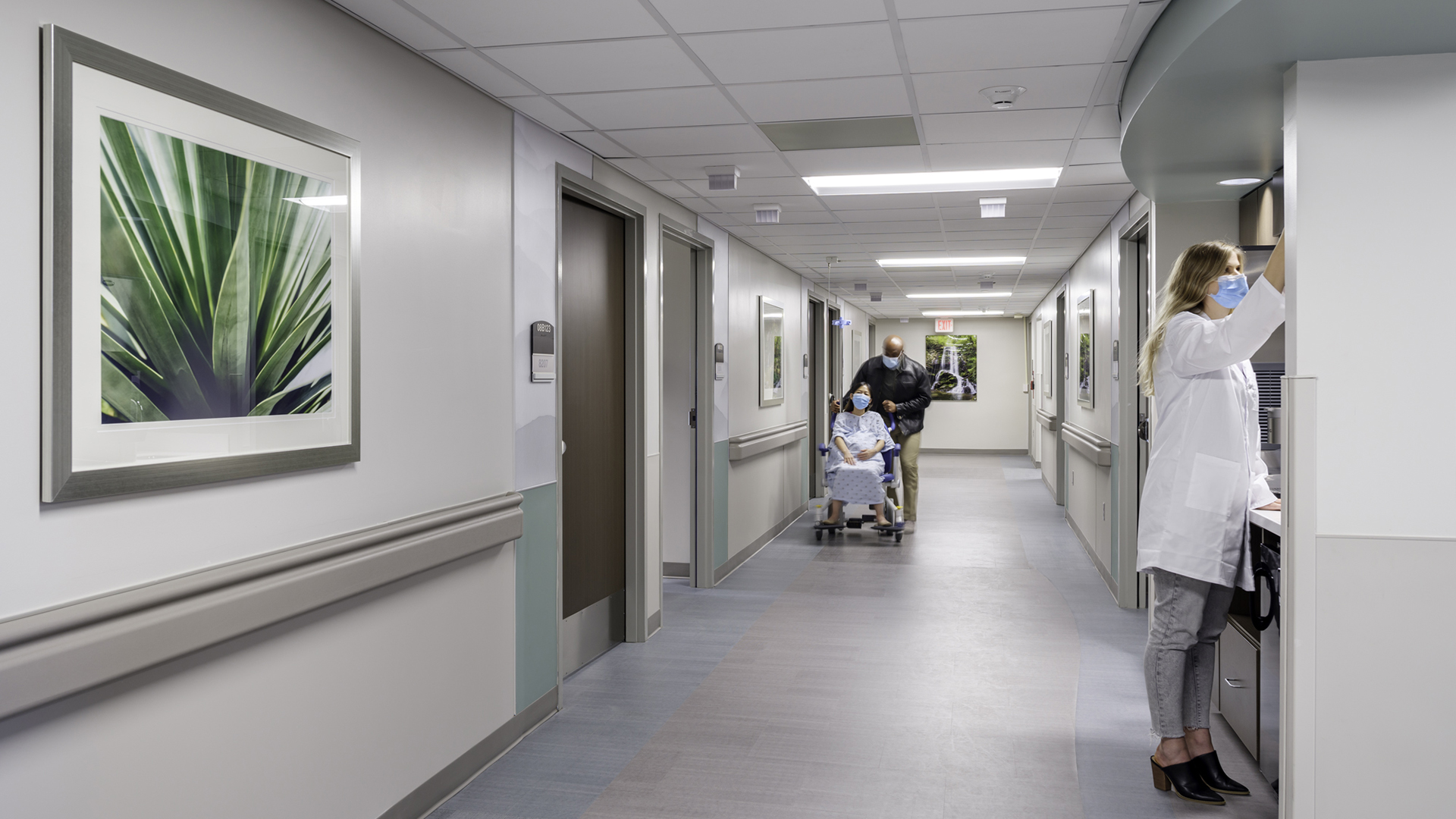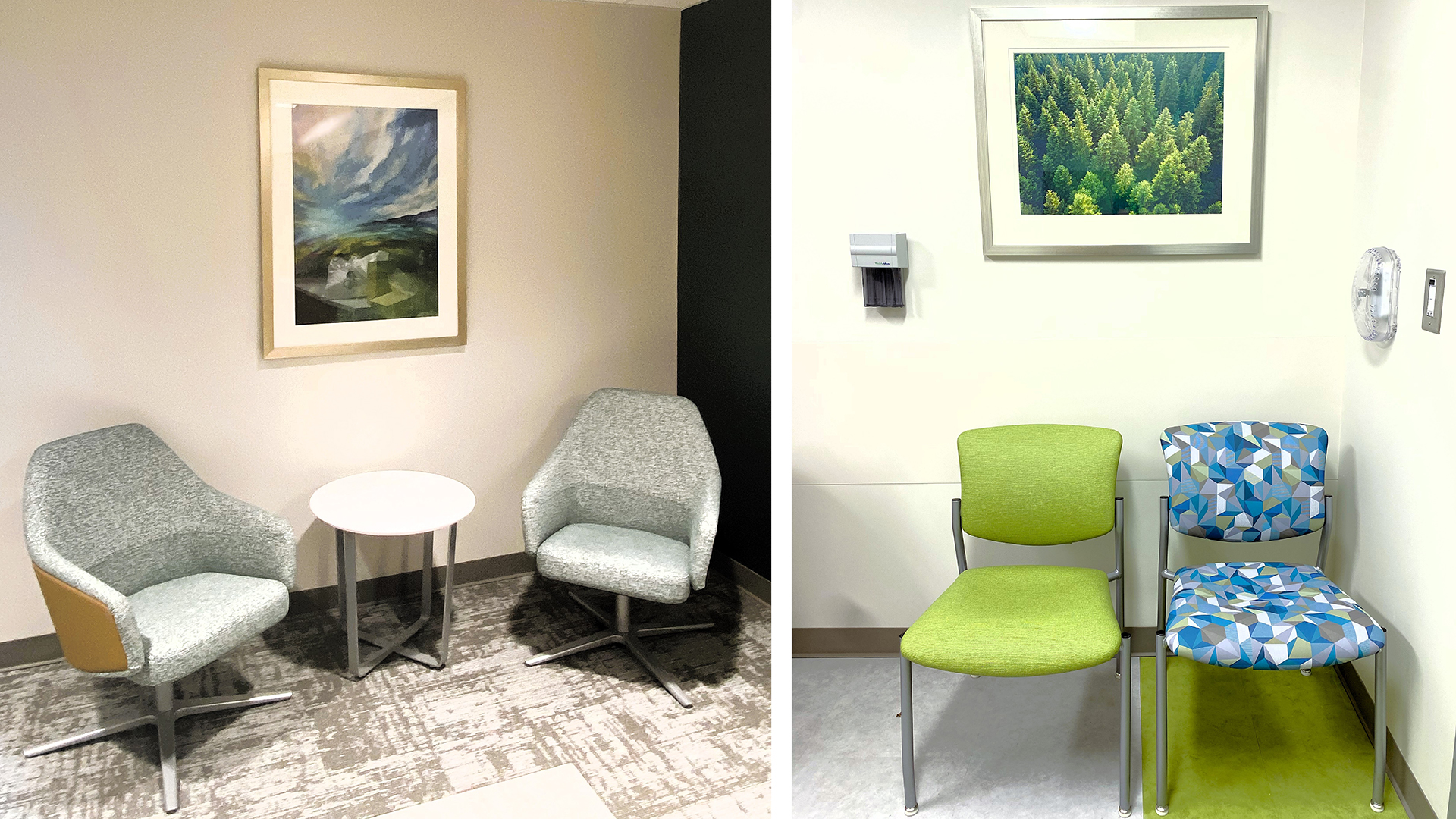Healthcare facilities can often feel intimidating, yet they are also the setting for some of life’s most meaningful and joyful moments. The atmosphere experienced by patients and caregivers during their stay leaves a lasting impression that can deeply influence how they remember their care.
Designing environments that evoke serenity and emotional comfort enhances the overall experience and supports the healing process in tangible ways. Art plays a pivotal role in this journey, serving as a visual connection to the outside world, a positive distraction from anxiety or pain, or a therapeutic tool through practices such as Art Therapy. Whether it’s a calming landscape in a patient room or a thoughtfully curated mural in a waiting area, art has the power to soothe, uplift, and support healing, making it an essential element in patient-centered care.
Building on this understanding, developing artwork guidelines for healthcare systems ensures that art is integrated intentionally and consistently across environments. Grounded in evidence-based design (EBD) principles and aligned with the values of patient-centered care, these guidelines serve as a framework for selecting, placing, and maintaining art that contributes to healing and emotional well-being. By standardizing approaches to content, framing, materials, and placement—while allowing flexibility for cultural relevance and facility-specific identity—healthcare organizations can enhance patient satisfaction, reinforce brand alignment, and elevate the overall standard of care.

THE ROLE OF EBD IN HEALTHCARE
Healthcare designers increasingly use evidence-based research to create environments that reflect industry best practices while prioritizing patients’ unique needs and well-being. Since the 1980s, thousands of studies have focused on the hospital-built environment, patient satisfaction, stress health outcomes, and overall healthcare quality. By grounding design decisions in research and measurable outcomes, healthcare environments can be thoughtfully crafted to support healing, safety, and a more positive patient experience.
Within this framework, art has been shown to play a critical role, contributing to environments that promote calmness, reduce stress, and support positive health outcomes. Evidence-based design research consistently demonstrates that artwork depicting nature and biophilic elements most significantly and positively impacts patient well-being. Exposure to natural imagery—such as landscapes, water scenes, and plant life—have been linked to reduced symptoms of depression, anxiety, and stress—even lowering heart rate and blood pressure (Ulrich, 1991).
A 2019 study applied semi-permanent opaque vinyl murals, known as window views, to the windows of pediatric patient rooms. Patients were randomly dispersed between rooms with either an aquatic mural, a tree mural, or no mural (the control condition). The results showed patients with murals in the rooms had improved heart rate and blood pressure compared to the control rooms (Pearson et al. (2019)).
These findings reinforce the broader understanding that nature-inspired imagery not only produces measurable physiological benefits—such as lowered heart rate and blood pressure—but also serves a deeper psychological function, offering patients a sense of familiarity and perceived control that supports emotional equilibrium and aids in the healing process. Beyond its calming effect, nature-inspired art provides a sense of familiarity, which can be a positive distraction from the clinical environment. Importantly, it helps patients regain perceived control in a setting where they often feel powerless, restoring emotional balance and supporting the healing process.
Conversely, certain types of art—such as overly complex, chaotic, or ambiguous images—can increase stress, particularly in vulnerable patient populations such as those in behavioral health, ICU, or pediatric settings. For example, a study conducted in 2011 examined the effects of nature vs. abstract art in a mental health facility, measuring patient agitation and anxiety levels through pro re nata (PRN) medication rates and nurse feedback. The findings revealed that on days when nature imagery was displayed, there was a significantly lower dispersion of PRN medication compared to days when abstract art was displayed (Nanda, Eisen, Zadeh, and Owen, 2011).
This does not suggest that abstract art should be excluded from healthcare environments but rather highlights the importance of thoughtful selection and appropriate placement. More recent research has shown that abstract art can support transcendence, helping to alleviate anxiety and pain by engaging the brain in a way that frees it from the constraints of reality (Rollins, 2021). By stimulating curiosity and prompting deeper cognitive engagement, abstract art can redirect focus, creating an opportunity for mental escape and emotional processing. However, further research—particularly in neuroscience—is still being conducted to better understand the brain’s nuanced response to abstract forms. Given its ability to challenge, stimulate, and captivate, abstract art is particularly well-suited for lobbies, public corridors, and staff areas, where visual interest and cognitive engagement are beneficial without the risk of overstimulating patients in more sensitive care settings.
Beyond decoration, art is a powerful, measurable, and intentional element that directly supports patient-centered care, offering visual comfort, emotional connection, moments of reflection, and even thought-provoking engagement throughout the healing journey. When evidence-based research is integrated into the development of artwork guidelines, it ensures that each piece is selected with purpose—contributing meaningfully to the well-being of patients, supporting staff morale, and reinforcing the healthcare system’s mission, values, and goals. This approach transforms art from an aesthetic afterthought into a strategic component of healing environments.
ART AS A TOOL FOR PATIENT-CENTERED CARE
Patient-centered care respects and responds to individual patient’s preferences, needs, and beliefs, ensuring their values guide all clinical decisions (The Institute of Medicine, 2001). Art powerfully enhancesthe healthcare environment by offering patients emotional support, cultural responsiveness, and personal meaning.
Patients typically have little autonomy over their environment or what is happening around them. However, art can offer a subtle yet meaningful sense of control by fostering a sense of normalcy and personal connection. For example, thoughtfully integrated artwork can transform a sterile clinical setting into a more welcoming, human-centered space, especially when it reflects local culture, familiar landscapes, or comforting themes. In doing so, art helps create an environment that feels less institutional and more supportive of emotional well-being, aligning with the core principles of patient-centered care (Patterson, E. (2017). A Patient’s Perception of Comfort is the Most Critical Part of the Patient Experience).

Developing Artwork Guidelines
Ensuring artwork is effectively implemented within a healthcare system begins with creating comprehensive artwork guidelines. The guidelines can exist as a stand-alone document or incorporated within the healthcare system’s design and facility standards. Artwork guidelines must balance aesthetics, healing impact, functionality, and operational considerations.
Step 1: Understand Mission, Purpose, and Goals
The first step is understanding the healthcare system’s mission, purpose, and goals for establishing the artwork guidelines. Ask: What does your organization want to accomplish with implementing an art program? Some objectives include enhancing the patient, staff, and visitor experience, supporting healing through evidence-based design, reinforcing brand identity, and ensuring consistency across all facilities.
Step 2: Define and Establish Scope
Next, clearly define and establish the scope, collaborating with key stakeholders and decision-makers. Identify the project tiers and target environments, including project sizes, facility types, spaces, and service lines. For example, a small children’s clinic would require fewer artwork pieces, with spaces identified as only patient-facing (i.e., exam rooms, corridors, and reception/waiting areas).
Step 3: Define and Plan for Artwork Types
After establishing the scope, our next step is to define artwork types and media, along with when and where they would be utilized. This can range from murals to framed artwork to digital displays/LED walls. The type can be significantly influenced by the service line and project tier. For instance, a capital project will have a larger budget, allowing multiple styles and media. This could include an interactive display accompanied by an original statement piece.
Step 4: Consider Content and Style
After determining the appropriate artwork types and media, consider content and style using EBD principles focused on patient-centered care. In this context, artwork should be selected or created to soothe, comfort, and emotionally support patients throughout their healing journey.
Research has shown that nature-inspired themes, rooted in biophilic design, are most effective at reducing stress and supporting wellness. Other content strategies include using familiar local or regional imagery, calming abstract patterns and organic forms, and avoiding anything distressing, chaotic, graphic, or politically charged. Additionally, artwork should be culturally inclusive and demographically appropriate, ensuring that all patients feel seen, respected, and emotionally supported in their environment.
Step 5: Standardize Framing
Standardizing framing is the easiest and most effective way to create visual consistency and reinforce brand identity across facilities. Since most artwork installed in healthcare environments is framed, using a consistent frame style, color, and material helps establish a cohesive and familiar aesthetic. This simple yet impactful approach ensures that artwork—regardless of subject or location—feels intentional, unified, and visually appealing, enhancing the overall environment and supporting the organization’s design standards.
Other elements include mounting methods, material durability—important for infection control and the maintenance team, and placement and spacing.
The behavioral health service line is an exception to typical mounting methods and should be clearly identified within the guidelines. Artwork applications in behavioral healthcare facilities need to be securely installed and mounted. Frames should be mounted using tamper-resistant screws allowing for the frame to be flush with the wall. Use rounded edges instead of sharp corners, and choose shatterproof polycarbonate glazing instead of glass.
SETTING THE STAGE FOR FUTURE SUCCESS
To ensure that artwork guidelines remain practical, sustainable, and easy to implement well beyond the initial installation, it’s essential to define a clear process for ongoing selection, approval, and maintenance. These next steps focus on building a long-term framework that supports consistent execution, fosters stakeholder collaboration, and allows for future adaptability—ensuring that the artwork program continues to enhance healing environments across the healthcare system.
This begins with collaboration among key stakeholders—including representatives from design, facilities, clinical leadership, and marketing—to develop a clear approval pathway for artwork that aligns with the healthcare system’s mission and design standards.
Step 6: Develop a Curated List of Vendors and Artists
A list of approved vendors and some artists should be curated to guide sourcing efforts. This list may include turnkey art consultants, independent artists, framing and installation professionals, and vendors specializing in healthcare-grade artwork. Establishing preferred partnerships helps maintain quality, consistency, and efficiency across projects.
Step 7: Identify Opportunities for Community Involvement
Additionally, identify opportunities for community involvement, especially in large capital projects where donor, patient, or local artist contributions can help create meaningful and place-based art experiences. This might include community art walls, curated collections from local schools, or artist commissions that reflect the identity of the surrounding neighborhood.
Step 8: Create a Checklist to Guide Implementation
Develop a checklist to support consistent implementation, detailing key steps like reviewing artwork for content suitability, verifying framing standards, coordinating installation with facilities, and documenting each piece for inventory.
Also, establish a rotation and maintenance plan to ensure artwork remains fresh, relevant, and well-maintained, allowing flexibility for future updates while preserving long-term integrity. These tools ensure it is selected and integrated intentionally, inclusively, and aligned with patient-centered care values.
Step 9: Create an Artwork Reference Library
As part of the guidelines, creating an artwork reference library that includes sample collections, mood boards, and thematic palettes will help ensure that artwork selections are appropriate, consistent, and aligned with the specific service line and project tier. Stakeholders, designers, and vendors can use the library as a visual aid to keep artwork aligned with the program goals.
Including art intake forms and floor plan examples streamlines the selection and installation process. Aligning these resources with the project’s scale and the patient population’s needs makes the reference library a valuable tool for preserving design integrity and ensuring flexibility across the healthcare system.

Step 10: Finalize an Implementation Plan
The final component of the artwork guidelines is the implementation plan, which outlines how the program will be introduced and sustained across the healthcare system. This plan may vary depending on the organization’s goals, resources, and overall strategy for integrating the guidelines.
Implementation may begin with a pilot location or phased rollout, allowing for testing, feedback, and refinement before expanding system-wide. The plan should include clear timelines for artwork rotation, as well as defined cleaning and maintenance procedures to ensure longevity, hygiene, and overall quality of the installations.
To evaluate the impact of the artwork, develop a post-implementation survey for staff and patients to complete approximately three months after installation. The feedback collected will help determine whether the artwork was well received, aligned with healing and aesthetic goals, or if any adjustments are needed. These insights are invaluable for informing future installations and improving the overall program.
A thoughtful and flexible implementation process turns the artwork guidelines into a living tool that adapts to the evolving needs of both the organization and the patients it serves.
CHALLENGES AND CONSIDERATIONS
Artwork in healthcare settings has consistently proven to support the healing process, yet—like all aspects of design—its style, content, and placement must be approached with thoughtful intention and informed expertise. Establishing clear guidelines can help ensure the consistent and effective integration of artwork across healthcare facilities while allowing for the flexibility needed to reflect each facility’s unique identity. By involving stakeholders, staff, and the local community in the decision-making process, the artwork can better reflect the needs, values, and preferences of the people who experience these spaces daily.
However, one of the key challenges in this approach is aligning diverse perspectives, as each group may have different views on what is appropriate, comforting, or meaningful. Still, this inclusive and collaborative process balances system-wide consistency and site-specific distinctiveness, ensuring each space feels cohesive and authentically connected to its community.
It’s important to recognize that not all artwork content suits every healthcare setting. While biophilic design is widely regarded as one of the most effective and accepted themes in healthcare environments, the specific execution of that content matters. For instance, macro photography of highly patterned natural elements can be overstimulating or anxiety-inducing in sensitive environments such as behavioral health units.
Similarly, abstract art, while visually engaging, has been shown through studies to be better received in public spaces like lobbies, where patients and visitors are more transient, as opposed to patient rooms, where a more calming and familiar atmosphere is often preferred. These nuances highlight the importance of contextual awareness and evidence-based decision-making when selecting artwork for different areas of care.
Budget constraints often limit the ability to invest in high-quality, impactful art, and even when the artwork is selected, logistical challenges related to installation, safety, infection control, and long-term maintenance can arise.
Lastly, without structured feedback or evaluation tools, measuring the artwork’s success and healing impact is difficult—making it hard to justify future investments. Addressing these challenges helps artwork play a meaningful role in creating a healing, inclusive, and patient-centered environment.
CONCLUSION
When curated with sensitivity to patient populations and clinical context, art can reduce stress, foster connection, and create a sense of calm, ultimately enhancing the overall care experience. As healthcare design continues to evolve, integrating artwork through an evidence-based lens ensures that art is not only aesthetically pleasing but deeply purposeful—supporting the emotional, psychological, and cultural needs of patients, families, and staff alike.
By establishing thoughtful artwork guidelines rooted in evidence-based design and patient-centered values, healthcare organizations can create cohesive, healing environments across all facilities. These guidelines serve as a strategic foundation for selecting, placing, and maintaining artwork that aligns with each organization’s mission, supports operational needs, and respects the unique identities of the communities they serve.
Moreover, by fostering interdisciplinary collaboration, prioritizing inclusivity, and encouraging community involvement, artwork programs can become more than just enhancements to physical space—they become reflections of empathy, intention, and healing. When art is viewed not as decoration but as a vital element of care, it transforms the healthcare experience—humanizing clinical spaces, reinforcing dignity, and affirming the essential connection between environment and well-being.
SOURCES
Patterson, E., Sanders, E., Sommerich, C. Lavender, S. Li, K. & Evans, K (2017). Meeting patient expectations during hospitalization: A grounded theoretical analysis of patient-centered room elements. HERD: Health Environments Research & Design Journal, 10 (5), 95-110.
Pearson, M., Gaines, K., Pati, D., Colwell, M., Motheral, M., & Adams, N. (2019). The physiological impact of window murals on pediatric patients. HERD: Health Environments Research & Design Journal, 12 (2), 116-129.
Institute of Medicine (US). (2001). Crossing the quality chasm: A new health system for the 21st century. Washington, DC: National Academies Press, pp.48-50.
Rollins, J. A. (2021). “Purpose-built” art in hospitals: Art with intent. Arts & Health, 13(3)
Nanda, U., Eisen, S., Zadeh, R., & Owen, D. (2011). Effect of visual art on patient anxiety and agitation in a mental health facility and implications for the business case. HERD: Health Environments Research & Design Journal, 18, 386-393.
Ulrich, R. (1991). Effects of interior design on wellness: Theory and recent scientific research. Journal of Health Care Interior Design, 3, 97-109.

